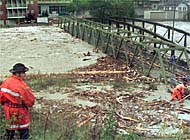Course of Rhone to be altered after flood disasters

The devastating floods which claimed 16 lives and caused widespread damage in canton Valais in October have prompted the local authorities to speed up an ambitious project to divert the course of the River Rhone.
The project is not simply a matter of bolstering existing defences. It aims to widen the river to minimise the risk of flooding, and to encourage nature to flourish.
It will take the canton several years to absorb the cost of October’s disaster. More than SFr 500 million worth of damage was done to waterways, roads, railways, buildings, forests and agricultural land. But it is hoped that in the long run a repetition of such devastation can be avoided.
The new project, known as the Third Correction of the Course of the Rhone, is a massive undertaking. It will take 30 years to complete and cost as much as SFr1 billion.
The federal government will provide 65 per cent of the funding, which amounts to a third of its total water management budget. The canton and communes will find the rest of the money.
“Even if there are only two floods like the one we had in October, the project will have paid for itself,” says Dominique Berod, the cantonal engineer in charge of the project.
“It has been estimated that the potential damage caused by a massive flood could amount to SFr7 billion. A project costing SFr1 billion would be money well spent,” he told swissinfo.
The plans for the project were unveiled in September, just a matter of weeks before the latest floods.
The devastation provided a graphic illustration why change was necessary. Protective dykes along the Rhone ruptured with alarming ease, putting at risk thousands of lives, property, industry and agriculture.
Berod says the floods proved “that our ideas, our philosophy and our predictions were correct”.
The current plans were started after floods hit the canton in 1987 and 1993.
It is the third time the Valais authorities have decided to change the course of the Rhone. The first was between 1860 and 1890, the second from 1930 to 1960. Both had the aim of straightening and reducing the size of the river to provide more land for economic activity such as farming and industry.
The effect was to reduce the space available to the river, virtually turning it into a canal. This may have boosted the canton’s economy but it increased the prospect of flooding.
A study also showed that half of the dykes on the 80-kilometre stretch between Brig and Martigny – the priority area for in the project – were in danger of breaking – something which happened at several points in October.
The latest floods have prompted the authorities to speed up the project. The time frame for the whole scheme remains 30 years, but three priority areas will be dealt with as a matter of urgency. These are around Viège, Sierre and Fully.
While safety and flood-prevention remain paramount, there are also environmental and socio-economic reasons for altering the flow of the river.
In the 19th Century, economic considerations were the priority, and the environment suffered as a result.
The Rhone is the backbone of the ecosystem in the region, but little remains of its biodiversity.
No fewer than 170 animal and plant species characteristic of the Rhone Valley are threatened, there are very few fish in the river, and only six per cent of the valley can be considered “natural”.
There is also a desire to re-establish the link between the people and the river. Where once the Rhone was a central part of the canton’s identity, now it has lost its appeal.
“Instead of fighting the river, we want to live with it and protect it,” says the speaker of the cantonal parliament, Gérard Rebord, who is also an engineer on the project.
It is for these reasons that a variety of methods are being used to alter the course of the Rhone.
“Wherever possible, we will widen the river. Where there are constraints, we will use classical methods, like raising dykes and deepening the river bed. By giving the river more space, we can meet our objectives,” says Berod.
Once the work is completed, the river will easily be able to accommodate volumes of water much greater than it had to cope with in October. Some 910 cubic metres of water was passing through Sion every second during the floods. Once the correction project is complete, it will be able to handle 1,200 cubic metres a second.
The authorities hope that widening the river will minimise the risk of flooding and encourage nature to flourish. The Rhone, they hope, will more aesthetically pleasing.
by Roy Probert

In compliance with the JTI standards
More: SWI swissinfo.ch certified by the Journalism Trust Initiative








You can find an overview of ongoing debates with our journalists here . Please join us!
If you want to start a conversation about a topic raised in this article or want to report factual errors, email us at english@swissinfo.ch.